The Hector Story
by Susie Yakowicz
The people of Fargo, North Dakota are no strangers to the Hector name. After all, the city’s main airport, Hector International, has carried it for nearly a century. But how the Hector family established a prominence in Fargo that led to the honorary designation dates back long before the airport ever broke ground, and it was a railroad rather than an airfield that helped pave the way.
Up until 1871, the community was little more than vast prairie, with the first white settler arriving in what is now Cass County in 1867. News of the Northern Pacific Railway’s plans to expand west into Dakota territory soon brought more people. After surveying the land, railroad officials determined Fargo–Moorhead would be the best place to bridge the Red River, setting the stage for a booming commerce center to emerge—and for Martin Solan Hector to lay his legacy.
Martin Hector, a Man of Opportunity
Born in 1852 in Hammerfest, Norway, Martin Hector immigrated with his family to the United States as a young teen. The Hectors eventually settled in Duluth, Minnesota, at the coaxing of Martin’s older brother, Jacob who had found work in the tugboat business on Lake Superior. Martin, however, wanted nothing to do with the water, especially after suffering seasickness on the trip to America. Besides, he had become an expert in lathing, a skill he learned from his father. When word got out that the Northern Pacific needed men with his talents to construct railway buildings, Martin jumped at the chance to help, even though it meant leaving his family in Duluth behind.
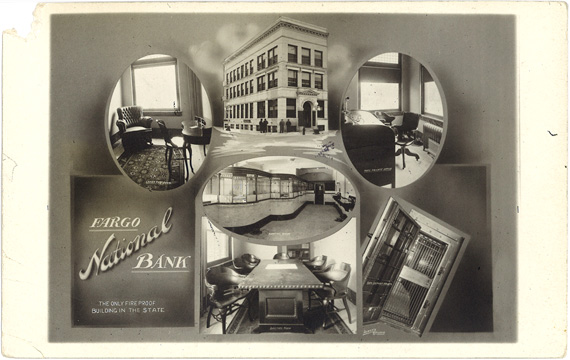 Fargo National Bank opened for business in 1897.
Fargo National Bank opened for business in 1897.
Martin’s work with the railroad brought him to Moorhead in the spring of 1872. Shortly after his arrival, a new opportunity fell into his lap. A gunfight had broken out between two well-known outlaws at Smith’s Saloon. When the owner of a different saloon went to investigate the commotion, he was killed by an erratic bullet, but not before ordering a large shipment of liquor that soon arrived by train. Martin couldn’t let the unclaimed liquor sit idle in a freight car—or a lucrative prospect pass him by. Using money saved from his railroad job, he purchased the shipment, secured land to build a structure around it, and so began his new business venture.
Under Martin’s diligent care, Hector Wholesale Wines & Liquors prospered. With Fargo growing at a faster rate than Moorhead, he moved the store to Front Street in Fargo and continued to enjoy success, along with a budding reputation as a business leader in the community. By the time North Dakota became a dry state in 1889, forcing Martin to close the liquor store, he had his sights set on something new: banking.
Martin purchased stock in Fargo’s first bank, Citizens National, and he was appointed Vice President in return. When the bank failed in 1896, Martin turned the loss into another profitable opportunity. He and several other Fargo businessmen, including O.J. deLendrecie and W.C. McFadden, reorganized the bank, calling it Fargo National Bank. Under the new leadership and with a capital investment of $50,000, Fargo National became one of the most substantial banking houses in the state. Martin served as the bank’s president for 41 years.
While Martin’s banking career blossomed, so did his service in the civic realm. He held positions on the Interstate Board of Immigration, the Fargo Commercial Club (predecessor of the Fargo Chamber of Commerce), and the Fargo City Council. Most notably, he served as president on the Board of Commissioners chosen to represent North Dakota at the 1893 World’s Fair in Chicago. Determined to prepare an exhibit properly highlighting North Dakota’s important resources, Martin dedicated a year of his time and energy, without pay, to complete the task.
Early Gifts to the Fargo–Moorhead Community
Martin also worked hard to promote a bridge that would allow easy access to Fargo for those living north of Moorhead. When people didn’t keep their pledges to pay for the bridge, Martin made up the difference, then drove the first vehicle across the bridge during the dedication ceremony in 1937.
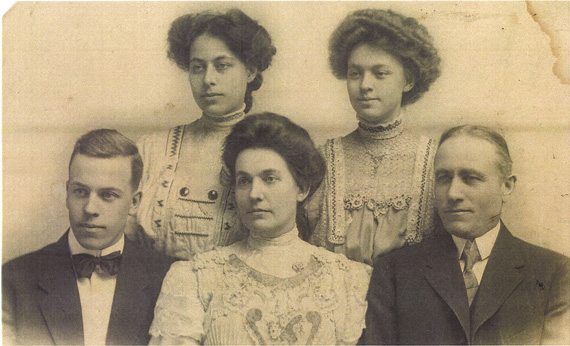 Martin Hector was a community booster and proud family man.
Martin Hector was a community booster and proud family man.
But Martin’s biggest contribution to the community came roughly six years earlier. City officials had been investigating the best site for an aviation field for the growing town. As luck would have it, Martin owned a choice parcel of land. In fact, with plenty of drainage facilities, no structural hazards, and convenience for mail and passenger transport, “the Hector property was the most satisfactory location available,” concluded Mayor Lynner in the local paper. Apparently, Martin thought so too.
In 1927, he leased 160 acres to the city of Fargo at no cost to be used as a municipal flying field. Less than five years later, the land became an outright gift. Soon after, the airport’s first gravel runway was constructed, along with a hangar for Northwest Airways. What to call the airfield took no debate. Given Martin’s extraordinary generosity, the city commission unanimously agreed to designate it Hector Field. The airport still bears Martin’s namesake today, an ever-present reminder of a man who helped transform a town with barely a spot on the map into a thriving metropolis.
Of course, the Hector legacy couldn’t be carried on without a family. And carry it on they did. Martin married Caroline Paulson while still in the liquor business. Together, they had four children, Martina (Minnie), Fred, Evelyn, and Clay, who died as an infant. As the only remaining son, Fred would be the one to step into Martin’s shoes as an influential Fargo businessman and community booster—but not necessarily by choice.
Fred Hector Meets Margaret Sewall of Bath, Maine
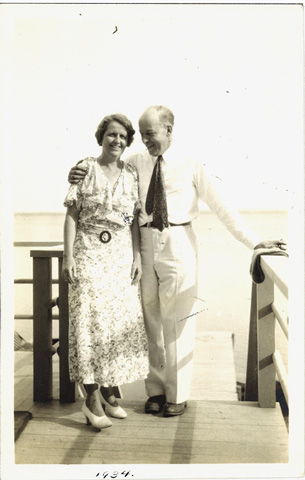 Fred and Margaret Hector enjoyed
Fred and Margaret Hector enjoyed
summer days at Detroit Lake.
As a young man, Fred didn’t stay in Fargo long. After two years of high school, he headed to the east coast, where he graduated from Phillips Exeter Academy in New Hampshire and later Harvard University and Harvard Law School. Fred’s sister, Evelyn also studied out east at a boarding school in Boston. It was there she met Fred’s future bride, Margaret Sewall of Bath, Maine. Roommates at Miss Chamberlayne’s Home and Day School for Girls in Boston, Margaret and Evelyn became fast friends. On several occasions, Evelyn invited Margaret to Fargo to visit her family, including her brother Fred.
With Margaret’s New England charm and elegance and Fred’s good looks and keen sense of humor, the two were soon smitten with each other. Their courtship lasted several years and included many trips between Bath, Boston, and Fargo. They married in 1914 at York Hall, Margaret’s impressive family residence in Bath. Their plan was to start life together in Boston, where Fred had accepted a job to practice law.
Born into a renowned shipbuilding family, Margaret grew up attending ceremonial ship launchings and festive galas. Her grandfather, Arthur Sewall had constructed over 35 deep-water sailing vessels for the United States Merchant Marine, including the only fleet of American-built steel square-riggers. He also served as the vice-presidential running mate to U.S. presidential candidate William Jennings Bryan in 1896. Her family entertained many influential people, including Calvin Coolidge and Eleanor Roosevelt. Accustomed to a high-society lifestyle, Margaret believed Boston would make a fine place to settle.
But arriving home from their honeymoon in Europe, Fred received a phone call that would change their course. Martin needed Fred at the bank, Margaret later wrote in her memoirs. “I suppose Martin felt that Fred belonged in Fargo, where he could take part in the family business.” After a trip back to Fargo, it was finalized. Although crushed at the thought of leaving her beloved New England behind, Margaret knew Martin was right. Fred’s place was in Fargo where he could carry on what his father had started, and her place was by Fred’s side.
Hector Homes and the Good Life
To make up for Margaret’s sacrifice, Fred agreed to bring a bit of New England to Fargo by building her a home to replicate the one she grew up in. Martin provided the land. The young Hector couple lived in what would become a Fargo showplace, complete with seven bedrooms, six bathrooms, and a host of exquisite antiques and furnishings from York Hall. On the other side of town, Martin’s home boasted showplace character too, with its third-floor ballroom, dining room that sat 24, and carriage house, which always held his latest Packard.
What brought the Hector homes to life, though, were the people who filled them, from the guests at their many dinner parties to the Hector children and grandchildren. Fred and Margaret began their family in 1916, with the birth of daughter Mary, followed by Dorothy, Peggy, Callie, and Fred Junior. By this time, Margaret had settled into a comfortable life in the Midwest, taking occasional trips back to Maine to appease any homesickness.
Meanwhile, Fred worked hard at the bank. He moved from teller to vice president to succeeding his father after his death as president. Like Martin, Fred became a civic leader. Not only did he serve on the Board of Education and Public Library Board, he contributed time and money to establishing a campsite in the Red River Valley for the Campfire Girls and a baseball park for the Northern League Ball Club. He also took great pride in the North Dakota Agricultural College football team. To show his appreciation after a win, he would invite the young men to his home for a venison dinner.
Life was good for Fred and Margaret until tragedy hit in the spring of 1939. Margaret had been on her way to the World’s Fair in New York when Fred suffered fatal complications from appendectomy surgery. She flew home as soon as she heard the news, arriving just in time to say goodbye. Fred’s death and the heavy responsibility of running a household alone, especially with two children under the age of 10, overwhelmed her. On top of that, Martin had passed away a year earlier. With two of her strongest supporters gone, she was tempted to pack up and move back to Maine, where her family beckoned her to return. But she knew her duty was to stay put and carry on the Hector name and all it stood for.
From Heartache to Heroics
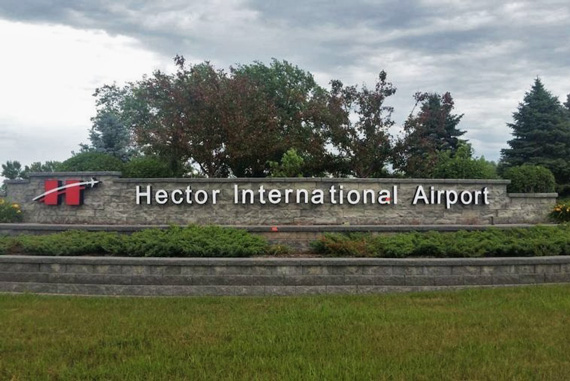 Hector International Airport grew from a legacy of giving by the Hectors.
Hector International Airport grew from a legacy of giving by the Hectors.
Image credit: Fargo Forum
Although Margaret soon resigned as her husband’s successor on the bank’s board of directors, she kept up the tradition of community giving. Two years after Fred died, she donated another 40 acres of land for expansion of Hector Airport. The gift made headlines, and with good reason. According to airport commissioner, H.C. Corrigan, to purchase the land would have taken $10,000—money that was needed for other improvements around town. Margaret’s donation allowed engineers to move buildings to the new strip of land, leaving more room for runways and aprons in the main section. It also provided for a new administration building and a larger parking area. Mostly, it helped make the airport a vital airfield for national defense.
After Fred’s passing, Margaret poured her energy into her children. She hired help to assist with cooking and cleaning, and she tried to keep as much continuity as possible. The family spent winters in Fargo and summers at their lake house in Detroit Lakes as she and Fred had done for years.
Losing their father couldn’t have been easy for any of the children either, especially young Fred, who was only six at the time of his dad’s death. Even so, he did what he needed to do, tending to his schoolwork in Fargo until he was old enough to leave home for Westminster Prep School in Simsbury, Connecticut. An academically gifted young man, he later attended Dartmouth College, graduating in 1955 magna cum laude.
Fred Hector, Jr.: Carrying on a Legacy
Fred planned to become a doctor after college, but reminiscent of his father’s fate, life took a U-turn. While serving at Fitzsimmons Army Hospital in Denver, Colorado, Fred met Earlyne Little. They married in 1959 and returned to Fargo, where Fred found his passion in something completely different from medicine: farming. He enrolled in agricultural courses at NDSU and soon began a lifelong journey of growing sugar beets, wheat, barley, and other crops on land acquired by his grandfather. When not tending to farm duties, he and Earlyne were busy raising their three children, Clay, Martin, and Carrie.
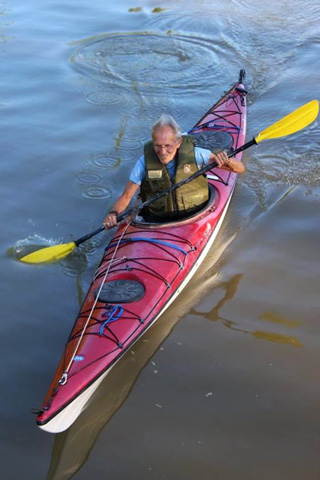 Kayaking became a favorite late-life
Kayaking became a favorite late-life
pastime for Fred Hector, Jr.
Like his father and grandfather, Fred lived life with a sense of purpose and determination. In fact, the three Hector men had much in common. Each was hard-working, resourceful, and productive, each took pride in the community and followed a code of duty, and each gave freely and generously to help improve the lives of others.
But Fred had qualities that made him unique, too. Although somewhat reclusive, he had an adventurous spirit that took him to places all over the world, from Mexico to Thailand to Taiwan, often returning with intriguing artifacts to commemorate the trips. As a young boy, he taught himself to sail, a talent that earned him prizes in many sailboat races and grew into a favorite pastime later in life. Whether sailing on Detroit Lake or off the coast of southwest Florida, Fred was fearless, never deterred by rough waters or an episode of capsizing the boat.
His love for adventure and the water didn’t wane as he grew older, either. In his eighties, he became especially fond of the Red River, kayaking it whenever weather and river levels permitted. At age 83, he participated in the River Keepers’ Race the Red competition, winning 3rd place in the solo male 6-mile kayak race, then first place a year later in the 12-mile race. Fred would live to tell the stories of his awe-inspiring experiences, keeping his listeners engaged and entertained for hours on end.
In keeping with the family’s custom of community giving, Fred gave generously and frequently. His greatest offering came in 1990 with a large donation to the city of Fargo. Together with Earlyne, he gifted 150 acres of land to the Fargo Park District that was used to build Rose Creek Golf Course. It was a move that contributed significantly to the growth and development of Fargo–Moorhead. Mayor Tim Mahoney lauded the gesture shortly after Fred’s death in June of 2019. The Rose Creek donation along with the history of generous giving by the Hector family, Mayor Mahoney told The Forum, “will continue to positively impact future generations in this community.”
The Hector Foundation, Fred’s final gift to the people of Fargo–Moorhead, plans to keep that sentiment—and the legacy Martin Hector laid so many years ago—alive.
Susie is a great-granddaughter of Martin Hector and niece of Fred Hector, Jr. She has published two family histories, From Down East to Midwest: The Memoirs of Margaret Sewall Hector (1889–1977) and Steel Glory: The Life of Shipbuilder Arthur Sewall (1835–1900), as well as hundreds of articles for websites, blogs, and print publications. For more information on her work, please visit her website.
Gallery
Select an image below to view it at full-size. Navigate through images with the on-screen controls.








